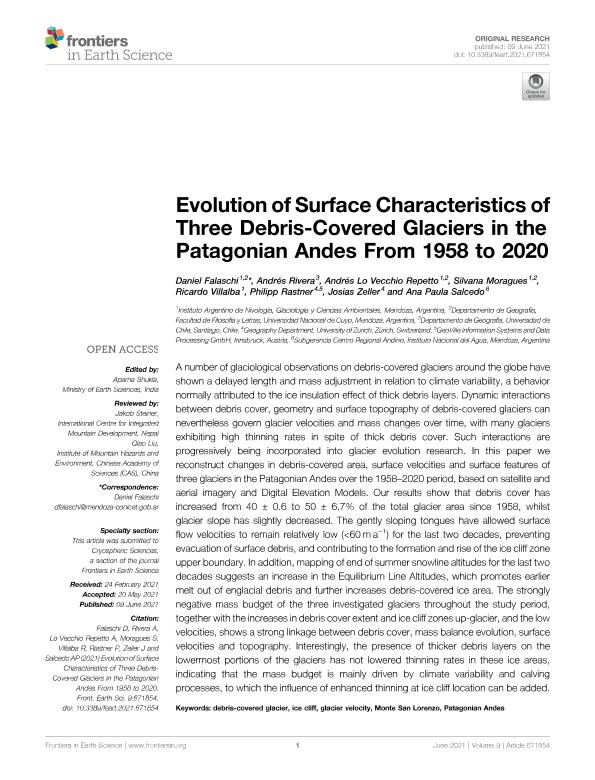Artículo
Evolution of Surface Characteristics of Three Debris-Covered Glaciers in the Patagonian Andes From 1958 to 2020
Falaschi, Daniel ; Rivera, Andrés; Lo Vecchio Repetto, Andrés
; Rivera, Andrés; Lo Vecchio Repetto, Andrés ; Moragues, Silvana Noelia
; Moragues, Silvana Noelia ; Villalba, Ricardo
; Villalba, Ricardo ; Rastner, Philipp; Zeller, Josias; Salcedo, Ana Paula
; Rastner, Philipp; Zeller, Josias; Salcedo, Ana Paula
 ; Rivera, Andrés; Lo Vecchio Repetto, Andrés
; Rivera, Andrés; Lo Vecchio Repetto, Andrés ; Moragues, Silvana Noelia
; Moragues, Silvana Noelia ; Villalba, Ricardo
; Villalba, Ricardo ; Rastner, Philipp; Zeller, Josias; Salcedo, Ana Paula
; Rastner, Philipp; Zeller, Josias; Salcedo, Ana Paula
Fecha de publicación:
06/2021
Editorial:
Frontiers Media
Revista:
Frontiers in Earth Science
ISSN:
2296-6463
Idioma:
Inglés
Tipo de recurso:
Artículo publicado
Clasificación temática:
Resumen
A number of glaciological observations on debris-covered glaciers around the globe have shown a delayed length and mass adjustment in relation to climate variability, a behavior normally attributed to the ice insulation effect of thick debris layers. Dynamic interactions between debris cover, geometry and surface topography of debris-covered glaciers can nevertheless govern glacier velocities and mass changes over time, with many glaciers exhibiting high thinning rates in spite of thick debris cover. Such interactions are progressively being incorporated into glacier evolution research. In this paper we reconstruct changes in debris-covered area, surface velocities and surface features of three glaciers in the Patagonian Andes over the 1958–2020 period, based on satellite and aerial imagery and Digital Elevation Models. Our results show that debris cover has increased from 40 ± 0.6 to 50 ± 6.7% of the total glacier area since 1958, whilst glacier slope has slightly decreased. The gently sloping tongues have allowed surface flow velocities to remain relatively low (<60 m a−1) for the last two decades, preventing evacuation of surface debris, and contributing to the formation and rise of the ice cliff zone upper boundary. In addition, mapping of end of summer snowline altitudes for the last two decades suggests an increase in the Equilibrium Line Altitudes, which promotes earlier melt out of englacial debris and further increases debris-covered ice area. The strongly negative mass budget of the three investigated glaciers throughout the study period, together with the increases in debris cover extent and ice cliff zones up-glacier, and the low velocities, shows a strong linkage between debris cover, mass balance evolution, surface velocities and topography. Interestingly, the presence of thicker debris layers on the lowermost portions of the glaciers has not lowered thinning rates in these ice areas, indicating that the mass budget is mainly driven by climate variability and calving processes, to which the influence of enhanced thinning at ice cliff location can be added.
Archivos asociados
Licencia
Identificadores
Colecciones
Articulos(IANIGLA)
Articulos de INST. ARG. DE NIVOLOGIA, GLACIOLOGIA Y CS. AMBIENT
Articulos de INST. ARG. DE NIVOLOGIA, GLACIOLOGIA Y CS. AMBIENT
Citación
Falaschi, Daniel; Rivera, Andrés; Lo Vecchio Repetto, Andrés; Moragues, Silvana Noelia; Villalba, Ricardo; et al.; Evolution of Surface Characteristics of Three Debris-Covered Glaciers in the Patagonian Andes From 1958 to 2020; Frontiers Media; Frontiers in Earth Science; 9; 6-2021; 1-19
Compartir
Altmétricas



